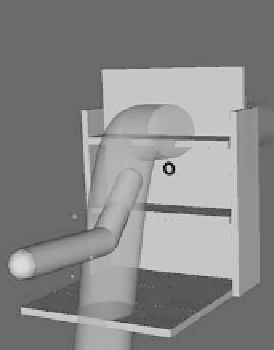Biomedical Engineering Reference
In-Depth Information
(a)
(b)
Figure 10.2
(a) patient in exoskeleton with the table top in front of her (b) predefined path
(in green), which was not shown to the stroke survivors. For color reference, see page 219.
if stroke survivors are able to learn from this sensory feedback, the number of
collisions with the virtual tunnel wall was counted during a movement task
with 15 repetitions. During several repeated movements patients were able to
decrease the number of collisions with the virtual wall. These findings indicate
that the patients were able to learn from sensory feedback when deviating from
the predefined path, and adjust the movement to the imposed trajectory (Molier
2009b).
In a training study of Kahn (2006) robotically active-assisted exercises were
compared with free reaching voluntary exercises (Kahn 2006). The robot con-
strained the subjects' movements, when it observed incorrect movement patterns,
by forcing subjects to attempt to generate a more normal pattern. It was concluded
that robotically assisting in reaching successfully improved armmovement ability.
Nevertheless, there were no detectable, additional values beyond the free reaching
movement practice (Kahn 2006).
Although provision of augmented sensory feedback seems to be a promising
tool, the role of applied robotic forces to improve motor function is still unclear.
10.5.2.3 Visual Feedback
Another way of stimulating motor learning is providing augmented visual feed-
back, for example by means of Virtual Reality (VR). By means of augmented visual
feedback several key elements of motor learning can be implemented in therapy,
such as active, functional, and intensive exercises in a motivating environment.
Also, multiple levels of difficulty can be presented for each exercise, allowing
individually adjustable training programs (Holden 2005). Several applications of
VR applied in stroke rehabilitation have shown a positive effect on motor function
(Henderson 2007).























